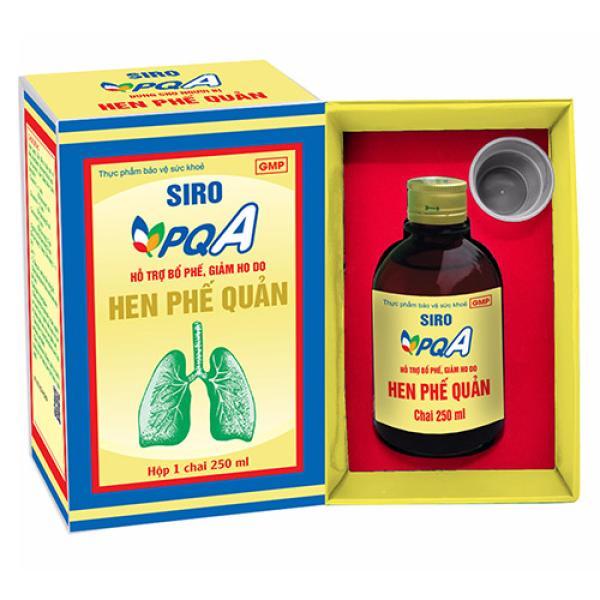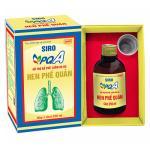MTA Bronchial Asthma Syrup Information
MTA Bronchial Asthma Syrup is a herbal medicine that supports lung health and reduces coughing caused by bronchial asthma for individuals suffering from asthma, excessive phlegm, and difficulty breathing.
Ingredients:
Each 250ml contains 125g of liquid extract equivalent to the following dry herbs:
- Bai Shao (White Peony): 30.0g
- Dang Gui (Angelica): 30.0g
- Mai Men Dong (Ophiopogon): 30.0g
- Jie Geng (Platycodon): 12.0g
- Dang Shen (Codonopsis): 6.0g
- Gan Cao (Licorice): 6.0g
- Tian Hua Fen (Trichosanthes Root): 6.0g
- Su Zi (Perilla Seed): 5.0g
Other excipients to make up 250ml.
Indications:
Supports lung health and reduces coughing due to bronchial asthma.
Target users:
Individuals with bronchial asthma causing coughing, excessive phlegm, and difficulty breathing.

How to Use:
Take 3 times a day. If experiencing difficulty breathing at night, take an additional dose before bedtime.
- Children under 2 years old: Consult a doctor.
- Children aged 2–5 years: Take 5ml per dose.
- Children aged 6–12 years: Take 10ml per dose.
- Children over 12 years old: Take 15ml per dose.
- Adults: Take 20ml per dose.
Each course should last 3 months. It is recommended to take 2–3 courses.
Note:
- Shake well before use as the syrup may settle.
- Do not use more than 4 weeks after opening the bottle.
Health Warnings:
- Do not use for pregnant women, individuals with high blood pressure, or those allergic to any ingredients of this product.
- Consult a doctor before using this product.
- This product is not a medication and should not replace prescribed medicines.
Storage:
Store in a dry, cool place, away from direct sunlight.
Expiration Date:
36 months from the manufacturing date. The production and expiration dates are printed on the packaging.
Registration Number: 12013/2019/ĐKSP
Health Certificate Number: 00295/2020/ATTP-XNQC

Bronchial Asthma
Bronchial asthma (commonly known as asthma in folk medicine) is a respiratory condition characterized by chronic inflammation of the airways.

Causes of Bronchial Asthma
There are many triggers for asthma attacks:
- Allergic Triggers: The most common cause.
- Respiratory allergens: Usually house dust, pollen, mold, animal fur, cigarette smoke, and bed bugs. Industrial substances like metal dust, petrol fumes, and paint vapors can also act as allergens.
- Food allergens: Seafood (shrimp, crab, fish, shellfish), eggs, chicken, peanuts.
- Medications: Some drugs, such as aspirin and penicillin, can trigger asthma attacks.
- Infectious Agents: Upper respiratory infections such as rhinitis, sinusitis, pharyngitis, and tonsillitis can trigger asthma in people with an allergic constitution.
- Non-allergic Triggers:
- Genetics: Family history of asthma.
- Psychological factors: Anxiety, stress, and emotional trauma.
- Sexual disorders.
Consequences
Bronchial asthma is a chronic respiratory disease that is common in the population, characterized by symptoms such as coughing, wheezing, shortness of breath, and chest tightness. If left untreated, it can lead to various complications, affecting the health and quality of life of the patient.
- Chest deformities
- Delayed physical development
- Chronic right heart failure (cor pulmonale)
- Respiratory infections
- Emphysema
- Pneumothorax and mediastinal air
- Collapsed lung
- Respiratory failure
Treatment Solutions for Bronchial Asthma
Western Medicine and Treatment Methods
Western medicine treats bronchial asthma, chronic bronchitis, and chronic obstructive pulmonary disease (COPD) with bronchodilators, antibiotics, and corticosteroids. This approach helps effectively treat acute cases, quickly relieve symptoms, and help patients avoid dangerous situations.
- Side Effects:
- Effective only in acute situations; once discontinued, the disease may recur.
- The disease progressively worsens, and drug resistance may develop.
- Long-term corticosteroid use can lead to immune system suppression, liver and kidney dysfunction, and osteoporosis.
Traditional Chinese Medicine (TCM) and Supportive Treatment for Asthma
According to Traditional Chinese Medicine, the primary cause of asthma is cold wind. Treatment involves dispersing cold wind. The famous physician Hải Thượng Lãn Ông taught that “To treat a disease, treat the root cause. If you treat the root, all ailments are cured; if you treat the surface, everything remains chaotic." TCM treats both the root cause and the symptoms, addressing the cause of the disease, not only curing the condition but also preventing its recurrence.

A traditional remedy, recorded by our ancestors in ancient medical texts for thousands of years, Lưỡng Trị Thang consists of Bạch thược, Đương quy, Mạch môn, Cát cánh, Đảng sâm, Cam thảo, Thiên hoa phấn, and Tô tử. It is known for its benefits in nourishing the lungs, resolving phlegm, and primarily treating asthma and bronchial asthma. Here's how each ingredient contributes:
- Tô tử: Regulates qi and resolves phlegm, relieves cough and asthma.
- Cát cánh: Unblocks lung qi, resolves phlegm, and helps expel toxic pus from the body.
- Đảng sâm: Treats weak lung qi, which causes persistent cough and asthma due to kidney deficiency, with shortness of breath.
- Cam thảo: Strengthens the spleen, nourishes qi, moistens the lungs, relieves cough, detoxifies, relieves pain, and harmonizes the actions of other herbs.
MTA Phế Quản, derived from the Lưỡng Trị Thang formula, supports the treatment of bronchial asthma in individuals with symptoms like cough, excessive phlegm, and difficulty breathing. This product is manufactured following GMP standards and is approved by the Ministry of Health for nationwide distribution.
COMBINATION OF PRODUCTS FOR EFFECTIVE RESULTS

Hen Phế Quản + Hoàng kỳ => Bổ tỳ, ích khí, sạch đờm, hết ho, khó thở

Hen Phế Quản + Bát tiên trường thọ => Tăng cường sức khỏe, bổ thận, nạp khí hết ho, khó thở

Bộ 4 sản phẩm giúp thông thoáng đường thở cho người hen phế quản không còn khó thở
Path to Overcoming Bronchial Asthma
- First 10 days: The disease may worsen during the initial phase, and patients might experience more difficulty in breathing as the process of dispersal takes place.
- 10-30 days: The body starts to expel phlegm from the superficial layers, with the disease fluctuating in severity. Patients may feel less fatigued over time.
- 2-4 months: Phlegm is expelled from deeper layers, and the functions of the spleen, lungs, and kidneys are balanced. Symptoms gradually decrease, become less frequent, and patients feel lighter, more comfortable, and sleep better.
- 4-6 months: The lungs are fully cleared, the body becomes stronger, and the immune system is boosted, eliminating breathing difficulties.
Home Remedies for Bronchial Asthma

CHUYÊN GIA CHIA SẺ VỀ HEN PHẾ QUẢN
Bác sỹ Phạm Hòa Lan chia sẻ về bệnh Hen Phế quản
GIỚI THIỆU DƯỢC PHẨM MTA

Dược phẩm MTA – Được sản xuất trên quy trình đạt chuẩn GMP
Đã đăng ký với FDA Hoa Kỳ

Nhà máy sản xuất dược phẩm đạt chuẩn GMP của MTA

Khu kiểm nghiệm đat chuẩn GLP của MTA
TRUYỀN THÔNG NÓI VỀ MTA













